Torrieri D. Principles of Spread-Spectrum Communication Systems
Подождите немного. Документ загружается.

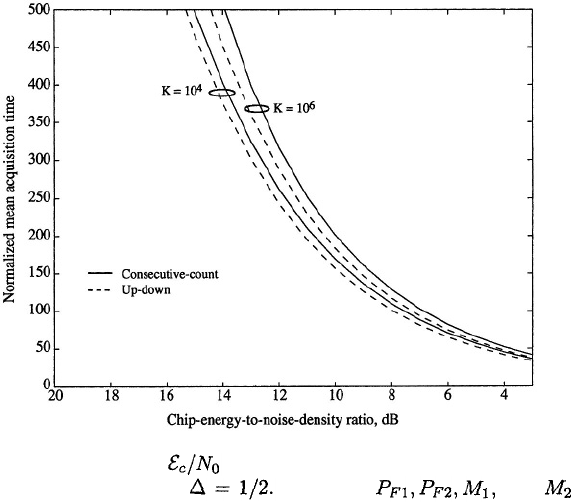
208
CHAPTER 4.
CODE SYNCHRONIZATION
Figure 4.14: NMAT versus for double-dwell systems in presence of fast
Rayleigh fading. Step size is Values of and are
optimized.
pulsed Gaussian noise jamming is present. When a rake receiver (Chapter 5 ) is
used, each finger of the receiver must acquire the timing of a separate multipath
signal. Whether matched filtering or a serial search is used, some mechanism
is needed to ensure that each finger acquires a distinct multipath signal [9].
An alternative to acquisition tests of fixed dwell time or number of detector
samples is sequential detection, which uses only the number necessary for a
reliable decision. Thus, some sample sequences may allow a quick decision,
while others may warrant using a large number of samples in the evaluation of a
single phase of the spreading waveform. The sequential probability ratio test [2],
[3] entails the recalculation of the likelihood ratio after each new detector sample
is produced. This ratio is compared with both upper and lower thresholds to
determine if the test is terminated and no more samples need to be extracted.
If the upper threshold is exceeded, the receiver declares acquisition and the
lock mode is entered. If the likelihood ratio drops below the lower threshold,
the test fails, and another code phase is tested. As long as the likelihood ratio
lies between the two thresholds, a decision is postponed and the ratio continues
to be updated. Although the sequential detector is capable of significantly
reducing the mean acquisition time relative to detectors that use a fixed number
of samples, it has a number of practical limitations. Chief among them is
the computational complexity of the calculation of the likelihood ratio or log-
likelihood ratio.
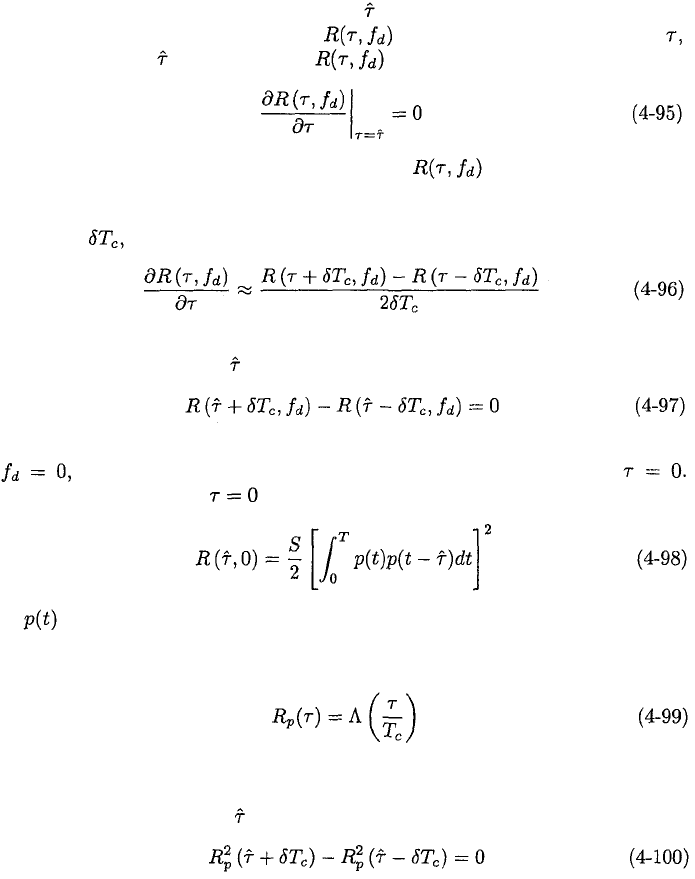
209
4.4
4.4.
CODE TRACKING
Code Tracking
Coherent code-tracking loops operate at baseband following the coherent re-
moval of the carrier of the received signal. An impediment to their use is
that the input SNR is usually too low for carrier synchronization prior to code
synchronization and the subsequent despreading of the received signal. Further-
more, coherent loops cannot easily accommodate the effects of data modulation.
Noncoherent loops operate directly on the received signals and are unaffected
by the data modulation.
To motivate the design of the noncoherent loop, one may adapt the statistic
(4-9). If the maximum-likelihood estimate is assumed to be within the interior
of its timing uncertainty region and is a differentiable function of
then the estimate that maximizes may be found by setting
A major problem with this approach is that given by (4-9) is not
differentiable if the chip waveform is rectangular. This problem is circumvented
by using a difference equation as an approximation of the derivative. Thus, for
a positive we set
This equation implies that the solution of (4-95) may be approximately obtained
by a device that finds the such that
To derive an alternative to this equation, we assume that no noise is present,
and that the correct timing offset of the received signal is
Substituting (4-2) with into (4-9) and using trigonometry, we obtain
If is modeled as the spreading waveform for a random binary sequence
and the interval [0, T] includes many chips, then the integral is reasonably
approximated by its expected value, which is proportional to the autocorrelation
where the triangular function is defined by (2-14). Substituting this result into
(4-97), we find that the maximum-likelihood estimate is approximately obtained
by a device that finds the such that

210
CHAPTER 4.
CODE SYNCHRONIZATION
Figure 4.15: Delay-locked loop.
The noncoherent delay-locked loop [10], which is diagrammed in Figure 4.15,
implements an approximate computation of the difference on the left-hand side
of (4-100) and then continually adjusts so that this difference remains near
zero. The estimate is used to produce the synchronized local spreading sequence
that is used for despreading the received direct-sequence signal. The code gen-
erator produces three sequences, one of which is the reference sequence used
for acquisition and demodulation. The other two sequences are advanced and
delayed, respectively, by relative to the reference sequence. The product
is usually equal to the acquisition step size, and thus usually but
other values are plausible. The advanced and delayed sequences are multiplied
by the received direct-sequence signal in separate branches.
For the received direct-sequence signal (4-2), the signal portion of the upper-
branch mixer output is
where and is the delay of the reference sequence relative to
the received sequence. Although is a function of time because of the loop
dynamics, the time dependence is suppressed for notational convenience. Since
each bandpass filter has a bandwidth on the order of where is the
duration of each symbol, is not significantly distorted by the filtering.
Nearly all spectral components except the slowly varying expected value of
are blocked by the upper-branch bandpass filter. Since
this expected value is the autocorrelation of the spreading sequence, the filter
output is
Any double-frequency component produced by the square-law device is ulti-
mately suppressed by the loop filter and thus is ignored. Since the
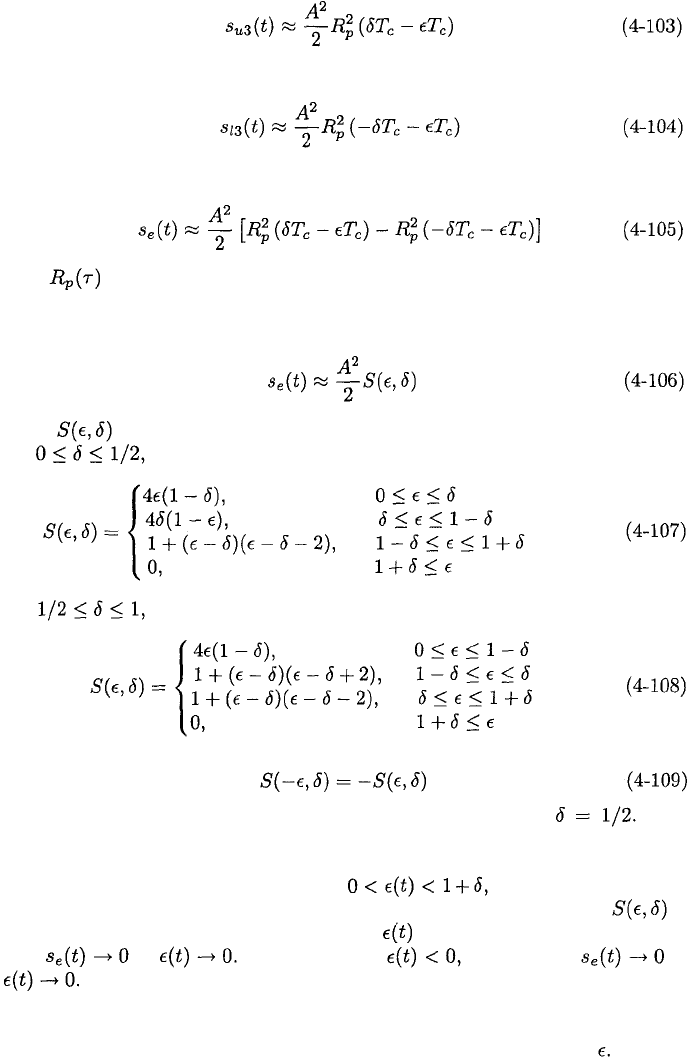
4.4.
CODE TRACKING
211
data modulation is removed, and the upper-branch output is
Similarly, the output of the lower branch is
The difference between the outputs of the two branches is the error signal:
Since is an even function, the error signal is proportional to the left-hand
side of (4-100).
The substitution of (4-99) and (2-14) into (4-105) yields
where is the discriminator characteristic or S-curve of the tracking loop.
For
For
In both cases,
Figure 4.16 illustrates the discriminator characteristic for The
filtered error signal is applied to the voltage-controlled clock. Changes in the
clock frequency cause the reference sequence to converge toward alignment with
the received spreading sequence. When the reference sequence
is delayed relative to the received sequence. As shown in Figure 4.16, is
positive, so the clock rate is increased, and decreases. The figure indicates
that as Similarly, when we find that as
Thus, the delay-locked loop tracks the received code timing once the
acquisition system has finished the coarse alignment.
The discriminator characteristic of code-tracking loops differs from that of
phase-locked loops in that it is nonzero only within a finite range of Outside
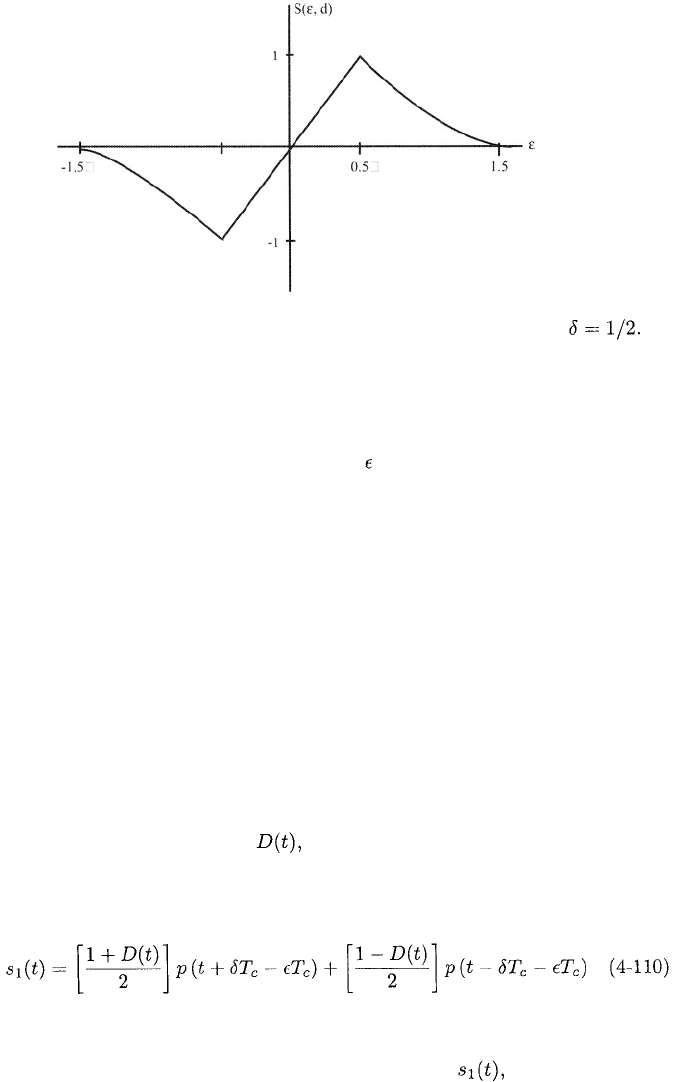
212
CHAPTER 4.
CODE SYNCHRONIZATION
Figure 4.16: Discriminator characteristic of delay-locked loop for
that range, code tracking cannot be sustained, the synchronization system loses
lock, and a reacquisition search is initiated by the lock detector. Tracking
resumes once the acquisition system reduces to within the range for which the
discriminator characteristic is nonzero.
When short spreading sequences are used in a synchronous direct-sequence
network, the reduced randomness in the multiple-access interference (Chapter
6) may cause increased tracking jitter or even an offset in the discriminator
characteristic [11]. For orthogonal sequences, the interference is zero when
synchronization exists, but becomes large when there is a code-phase error in
the local spreading sequence. In the presence of a tracking error, the delay-
locked-loop arm with the larger offset relative to the correct code phase re-
ceives relatively more noise power than the other arm. This disparity reduces
the slope of the discriminator characteristic and, hence, degrades the tracking
performance. Moreover, because of the nonsymmetric character of the cross-
correlations among the spreading sequences, the discriminator characteristic
may be biased in one direction, which will cause a tracking offset.
The noncoherent tau-dither loop, which is depicted in Figure 4.17, is a lower-
complexity alternative to the noncoherent delay-locked loop. The dither gener-
ator produces the dither signal
a square wave that alternates between +1
and –1. This signal controls a switch that alternately passes an advanced or
delayed version of the spreading sequence. In the absence of noise, the output
of the switch can be represented by
where the two factors within brackets are orthogonal functions of time and
alternate between +1 and 0. Only one of the factors is nonzero at any instant.
The received direct-sequence signal is multiplied by filtered, and then
applied to a square-law device. If the bandpass filter has a sufficiently narrow
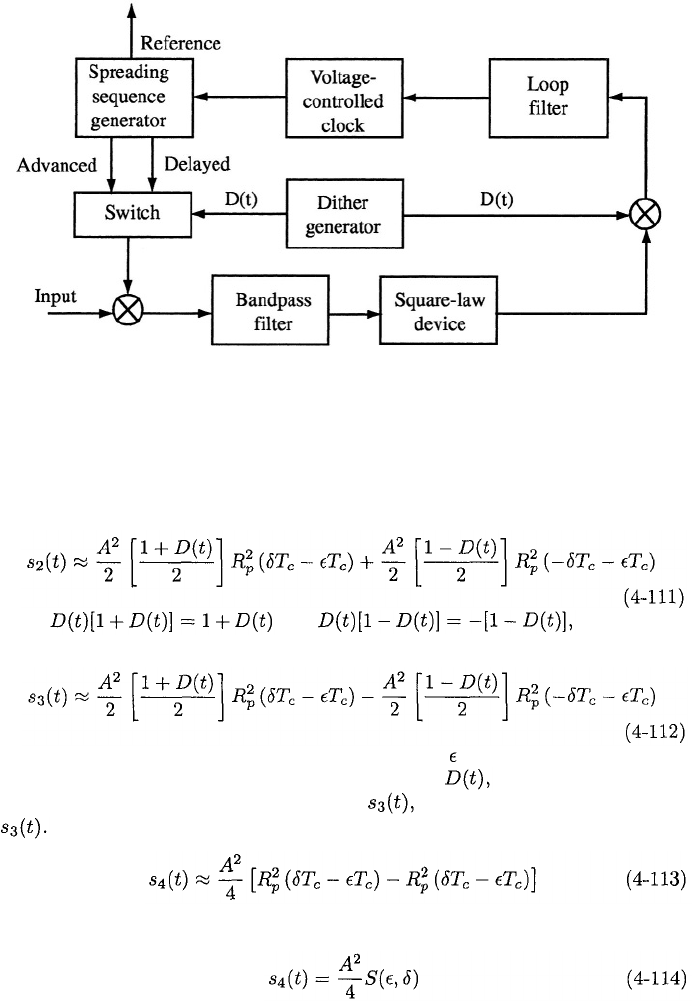
4.4.
CODE TRACKING
213
Figure 4.17: Tau-dither loop.
bandwidth, then a derivation similar to that of (4-103) indicates that the device
output is
Since and the input to
the loop filter is
which is a rectangular wave if the time variation of is ignored. Since the loop
filter has a narrow bandwidth relative to that of its output is approx-
imately the direct-current component of which is the average value of
Averaging the two terms of (4-112), we obtain the filter output:
The substitution of (4-99) yields the clock input:
where the discriminator characteristic is given by (4-107) to (4-109). Thus, the
tau-dither loop can track the code timing in a manner similar to that of the
delay-locked loop. A detailed analysis indicates that the tau-dither loop pro-
vides less accurate code tracking [2], [3]. However, the tau-dither loop requires

214
CHAPTER 4.
CODE SYNCHRONIZATION
less hardware than the delay-locked loop and avoids the need to balance the
gains and delays in the two branches of the delay-locked loop.
In the presence of frequency-selective fading, the discriminator characteris-
tics of tracking loops are severely distorted. Much better performance is poten-
tially available from a noncoherent tracking loop with diversity and multipath-
interference cancellation [12], but a large increase in implementation complexity
is required.
4.5
Frequency-Hopping Patterns
The synchronization of the reference frequency-hopping pattern produced by
the receiver synthesizer with the received pattern may be facilitated by pre-
cision clocks in both the transmitter and the receiver, feedback signals from
the receiver to the transmitter, or transmitted pilot signals. However, in most
applications, it is necessary or desirable for the receiver to be capable of obtain-
ing synchronization by processing the received signal. During acquisition, the
reference pattern is synchronized with the received pattern to within a fraction
of a hop duration. The tracking system further reduces the synchronization er-
ror, or at least maintains it within certain bounds. For communication systems
that require a strong capability to reject interference, matched-filter acquisition
and serial-search acquisition are the most effective techniques. The matched
filter provides rapid acquisition of short frequency-hopping patterns, but re-
quires the simultaneous synthesis of multiple frequencies. The matched filter
may also be used in the configuration of Figure 4.2 to detect short patterns
embedded in much longer frequency-hopping patterns. Such a detection can be
used to initialize or supplement serial-search acquisition, which is more reliable
and accommodates long patterns.
Matched-Filter Acquisition
Figure 4.18 shows a programmable matched-filter acquisition system that pro-
vides substantial protection against interference [13]. It is assumed that a single
frequency channel is used during each hop interval that occurs during acqui-
sition. One or more programmable frequency synthesizers produce tones at
frequencies which are offset by a constant frequency from the
consecutive frequencies of the hopping pattern for code acquisition. Each tone
multiplies the received frequency-hopping signal and the result is filtered so that
most of the received energy is blocked, except the energy in a frequency-hopping
pulse at a specific frequency. The threshold detector of branch produces
if its threshold is exceeded, which ideally occurs only if the received sig-
nal hops to a specific frequency. Otherwise, the threshold detector produces
The use of binary detector outputs prevents the system from being
overwhelmed by a few strong interference signals. Input of the compara-
tor is the number of frequencies in the hopping pattern that were received in
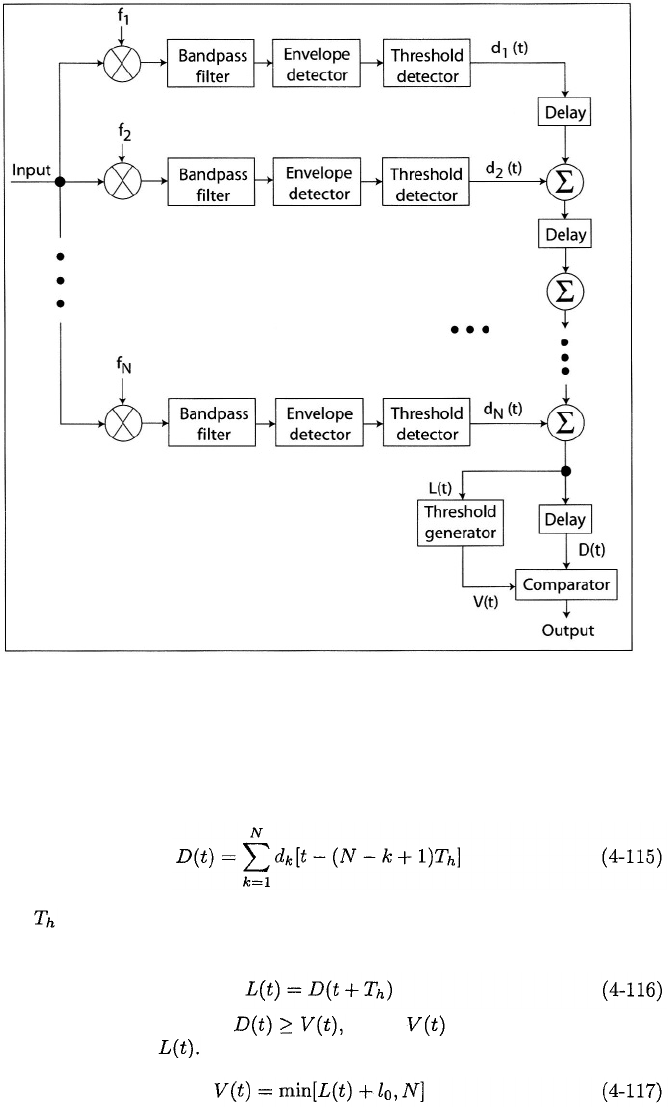
4.5.
FREQUENCY-HOPPING PATTERNS
215
Figure 4.18: Matched-filter acquisition system with protection against interfer-
ence.
succession. This discrete-valued, continuous-time function is
where is the hop duration. These waveforms are illustrated in Figure 4.19(a)
for N = 8. The input to the threshold generator is
Acquisition is declared when where is an adaptive threshold
that is a function of An effective choice is
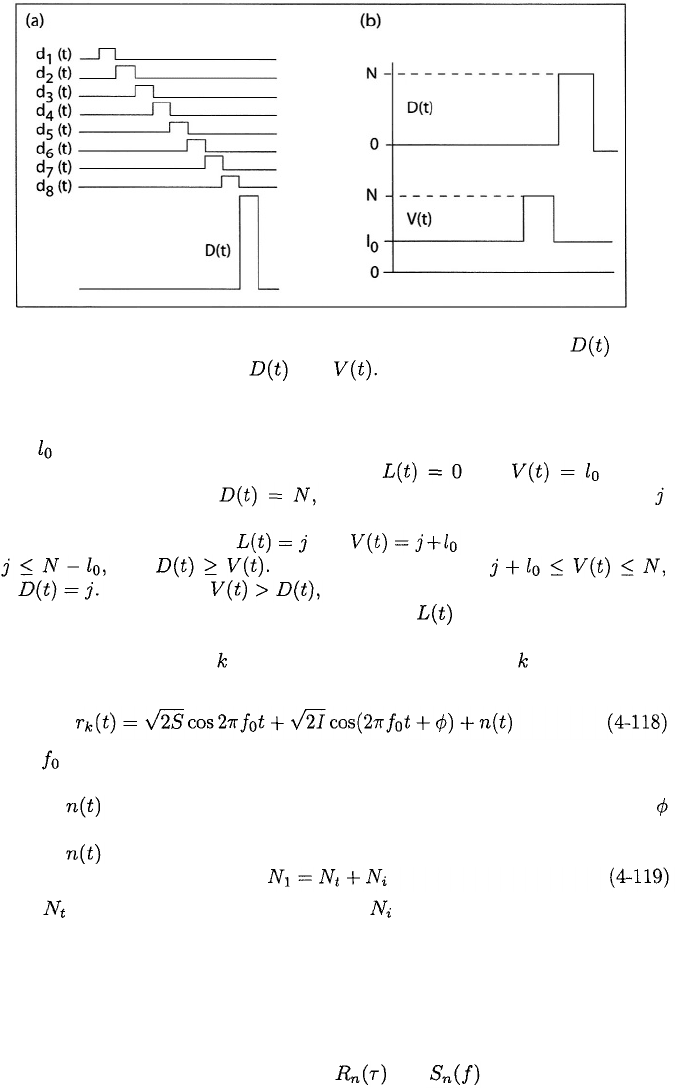
216
CHAPTER 4.
CODE SYNCHRONIZATION
Figure 4.19: Ideal acquisition system waveforms: (a) formation of when
N = 8, and (b) comparison of and
where is a positive integer.
In the absence of noise and interference, and during
the hop interval in which as illustrated in Figure 4.19(b). If
of the N frequency channels monitored by the matched filter receive strong,
continuous interference, then and during this hop interval
if and During other intervals,
but Therefore, and the matched filter does not declare
acquisition. False alarms are prevented because provides an estimate of
the number of frequency channels with continuous interference.
When acquisition tone is received, the signal in branch of the matched
filter
is
where is the intermediate frequency, the first term is the desired signal with
average power S, the second term represents tone interference with average
power I, is zero-mean, stationary Gaussian noise and interference, and
is the phase shift of the tone interference relative to the desired signal. The
power in is
where is power of the thermal noise and is the power of the statistically
independent noise interference.
Bandpass filters are used instead of filters matched to the acquisition tones
because the appropriate sampling times are unknown. The passbands of the
bandpass filters in the branches are assumed to be spectrally disjoint so that
tone interference entering one branch has negligible effect on the other branches,
and the filter outputs are statistically independent of each other. To prove the
statistical independence of the noise, let and denote the autocorre-
lation and power spectral density, respectively, of the stationary Gaussian noise
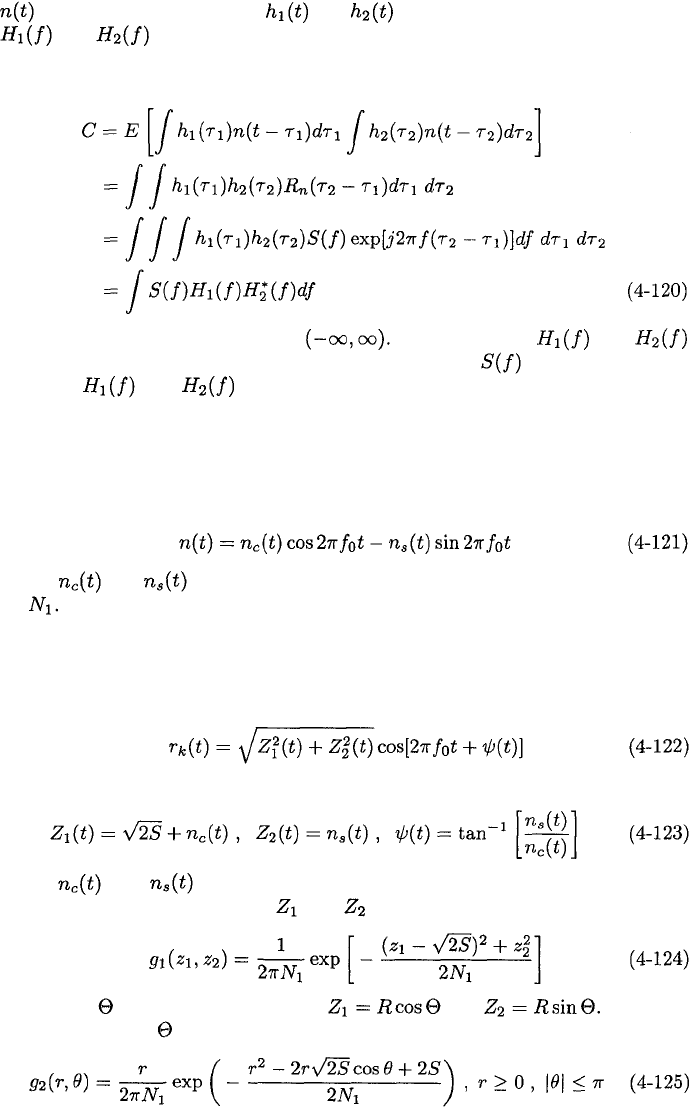
4.5.
FREQUENCY-HOPPING PATTERNS
217
in the received signal. Let and denote the impulse responses and
and the transfer functions of two bandpass filters. Since the same
Gaussian noise process enters both filters, their outputs are jointly Gaussian.
The cross-covariance of the jointly Gaussian, zero-mean filter outputs is
where all the integrals extend over Thus, C = 0, if and
are spectrally disjoint. If the noise is white and, hence, is a constant, then
C = 0 if and are orthogonal. When C = 0 for all pairs of band-
pass filters, the threshold-detector outputs in the N branches are statistically
independent.
Suppose that noise interference is present in a branch, but that tone in-
terference is absent so that I = 0. The stationary Gaussian noise has the
representation (Appendix C.2)
where and are zero-mean Gaussian processes with noise powers equal
to In practice, the matched filter of Figure 4.18 would operate in contin-
uous time so that acquisition might be declared at any moment. However, for
analytical simplicity, the detection and false-alarm probabilities are calculated
under the assumption that there is one sample taken per hop dwell time. From
(4-119) with I = 0 and (4-121), it follows that
where
Since and are statistically independent (Appendix C.2), the joint
probability density function of and at any specific time is
Let R and be implicitly defined by and The joint
density of R and is
